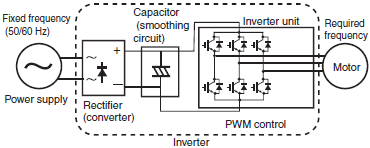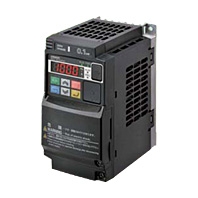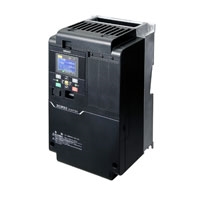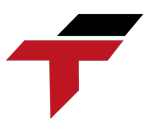OMRON Inverters
OMRON Inverters provide for energy-efficient operation of facilities and machines with fine speed control. EtherCAT Communications with optional unit.
What Is an Inverter?
An OMRON inverters controls the frequency of power supplied to an AC motor to control the rotation speed of the motor.
Without an inverter, the AC motor would operate at full speed as soon as the power supply was turned ON. You would not be able to control the speed, making the applications for the motor limited. The use of an inverter to adjust the speed and acceleration of an AC motor increases the range of applications of the motor compared with a motor that operates at a constant speed. The speed of a motor is normally measured as the number of revolutions per minute (rpm). The acceleration rate is given as the change in speed over a specific period of time.
Inverter Features
Freely Set and Change AC Power Frequency and Voltage
An inverter uses this feature to freely control the speed and torque of a motor.

This type of control, in which the frequency and voltage are freely set, is called pulse width modulation, or PWM. The inverter first converts the input AC power to DC power and again creates AC power from the converted DC power using PWM control. The inverter outputs a pulsed voltage, and the pulses are smoothed by the motor coil so that a sine wave current flows to the motor to control the speed and torque of the motor.

The voltage output from the inverter is in pulse form.
The pulses are smoothed by the motor coil, and a sine wave current flows. As a result, the output from a general-purpose inverter cannot be used for equipment other than motors.

Multi-function Compact Inverter
3G3MX2-V1
High starting torque and torque control capability in open loop mode give you full control of your machine dynamics and performance. Options for all of the major open network systems.
Torque master
The OMRON Inverters MX2-V1 delivers 200% starting torque near stand-still (0.5 Hz) and can operate in torque control in open loop mode. This allows the OMRON MX2 Inverter to be used in applications where closed loop AC vector drives were previously used.
Easy network integration
Standard industrial networks, such as EtherCAT, CompoNet or DeviceNet as options. High-speed EtherCAT provides solutions for the entire system from input to output with Sysmac Series.
Easy communications setting
Built-in RS-485 Modbus communications. OMRON Function Blocks are available for the CP H/L and CJ-series PLCs. Those control the MX2-V1 via Modbus communications easily.

High-function General-purpose Inverters
3G3RX2
This high performance inverter offers the same usability as the previous model, which allows easy replacement.
Easy replacement
The OMRON Inverters RX2 Series with the same mounting dimension as the previous model will fit in the existing control panel or mounting location. In addition, the same setting software CX-Drive can be used for the RX2 Series. Parameter settings and programs used for the previous model can be easily converted and transferred to the RX2 Series.
Note: The depth of some models may vary.
Built-in EMC Filter
Built-in noise filters corresponding to the European EMC Directive IEC61800-3 2nd Environment Category C3 and UL Power Conversion Equipment/UL61800-5-1 will save external hardware and extra cost.
Easy setup and operation
The new full-color LCD operator, which replaced the previous 7-segment display, makes setup and operation more intuitive and easier. The parameter copy function of the operator allows you to quickly copy parameter settings to other RX2 Inverters.
Application customized
The OMRON Inverters RX2 can perform simple sequence control programmed using support software CX-Drive.
Crane control, tension control, and other large-scale processes that require fast control speeds can be configured without a PLC, optimizing costs.
As induction motors can be used to achieve simple speed control at a relatively low cost, they are used in many applications. They can be operated just by connecting an AC power supply, so installation is extremely easy. Generally, a cooling fan is attached to the back to help dissipate heat generated by the motor.
Torque Boost (Torque Compensation)
In low-frequency ranges, voltage drop has a large impact, reducing the motor torque. To compensate for this, adjustments are made to output a high voltage at the required frequency. This function is called torque boost or torque compensation. Two torque boost options are available: Manual torque adjustment and automatic torque adjustment.
Inverter Overload Detection
There are two types of overloads with an inverter: inverter overload and motor overload. Overload detection is performed to protect both the inverter and motor from burning.
Inverter Overvoltage Detection and Braking Function
When a motor decelerates, or when the load descends, the motor serves as a generator to feed back the energy to the inverter. This phenomenon is known as regeneration.
If the regenerative energy is too large to be stored in the inverter, it causes an overvoltage.
Regenerative processing uses the braking circuits built into the inverter to convert the regenerated energy into heat via resistors, preventing an overvoltage.
